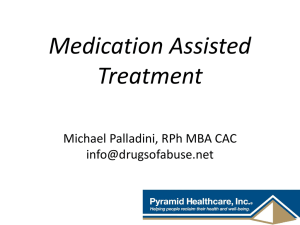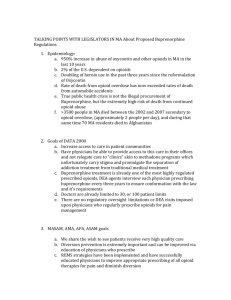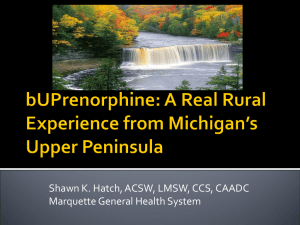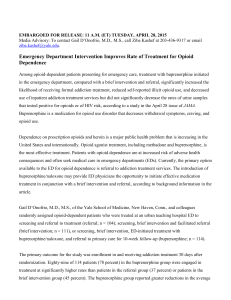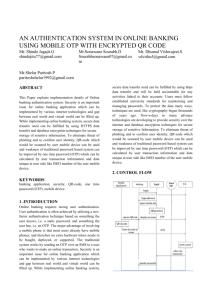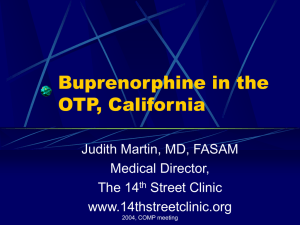CoOP model example Stoller_JHM
advertisement
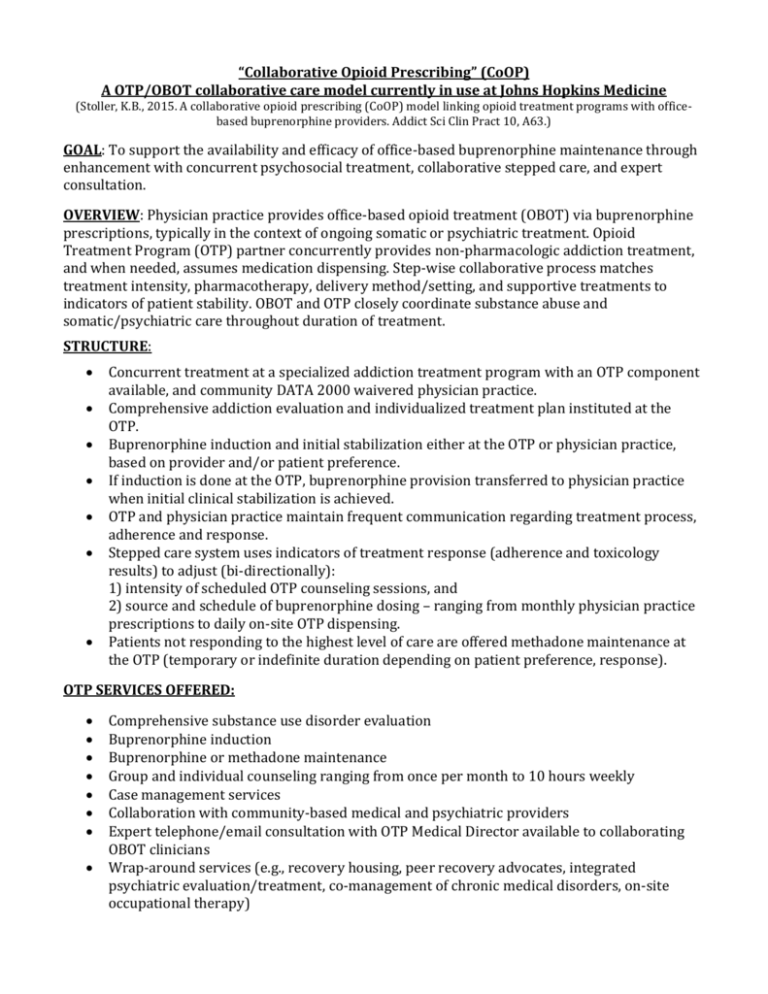
“Collaborative Opioid Prescribing” (CoOP) A OTP/OBOT collaborative care model currently in use at Johns Hopkins Medicine (Stoller, K.B., 2015. A collaborative opioid prescribing (CoOP) model linking opioid treatment programs with officebased buprenorphine providers. Addict Sci Clin Pract 10, A63.) GOAL: To support the availability and efficacy of office-based buprenorphine maintenance through enhancement with concurrent psychosocial treatment, collaborative stepped care, and expert consultation. OVERVIEW: Physician practice provides office-based opioid treatment (OBOT) via buprenorphine prescriptions, typically in the context of ongoing somatic or psychiatric treatment. Opioid Treatment Program (OTP) partner concurrently provides non-pharmacologic addiction treatment, and when needed, assumes medication dispensing. Step-wise collaborative process matches treatment intensity, pharmacotherapy, delivery method/setting, and supportive treatments to indicators of patient stability. OBOT and OTP closely coordinate substance abuse and somatic/psychiatric care throughout duration of treatment. STRUCTURE: Concurrent treatment at a specialized addiction treatment program with an OTP component available, and community DATA 2000 waivered physician practice. Comprehensive addiction evaluation and individualized treatment plan instituted at the OTP. Buprenorphine induction and initial stabilization either at the OTP or physician practice, based on provider and/or patient preference. If induction is done at the OTP, buprenorphine provision transferred to physician practice when initial clinical stabilization is achieved. OTP and physician practice maintain frequent communication regarding treatment process, adherence and response. Stepped care system uses indicators of treatment response (adherence and toxicology results) to adjust (bi-directionally): 1) intensity of scheduled OTP counseling sessions, and 2) source and schedule of buprenorphine dosing – ranging from monthly physician practice prescriptions to daily on-site OTP dispensing. Patients not responding to the highest level of care are offered methadone maintenance at the OTP (temporary or indefinite duration depending on patient preference, response). OTP SERVICES OFFERED: Comprehensive substance use disorder evaluation Buprenorphine induction Buprenorphine or methadone maintenance Group and individual counseling ranging from once per month to 10 hours weekly Case management services Collaboration with community-based medical and psychiatric providers Expert telephone/email consultation with OTP Medical Director available to collaborating OBOT clinicians Wrap-around services (e.g., recovery housing, peer recovery advocates, integrated psychiatric evaluation/treatment, co-management of chronic medical disorders, on-site occupational therapy) STEPPED CARE SYSTEM (shaded cells indicate intensified elements): Medication Rx or Dispensing Location OBOT office prescription OBOT office prescription Medication Rx or Dispensing Frequency 4 weeks prescription 1 week prescription Step: Opioid Agonist medication 1: Stable OBOT Buprenorphine 2: Intensive OBOT Buprenorphine 3: OTP Buprenorphine Buprenorphine OTP dispensary Daily dispensing Intensive Methadone OTP dispensary Daily dispensing Intensive 4: OTP Methadone Counseling intensity at OTP Standard/Low Intensive Step 1 - “Stable OBOT”: (Patient stable in treatment) Physician practice: Long prescription fill duration as indicated OTP: Low-level counseling services Step 2: “Intensive OBOT”: (Patient begins to destabilize in Step 1) Physician practice: Decrease prescription fill duration (e.g., to once weekly) OTP: Intensify treatment (increase counseling frequency; may add other elements such as involve drug-free support person, support productive activity, consider disulfiram, etc.) Step 3: OTP buprenorphine: (Did not stabilize in Step 2) Physician practice: Stop OBOT prescriptions. OTP: Start opioid maintenance treatment. Dispense buprenorphine daily through the dispensary until stabilization occurs. Continue intensive counseling schedule. Step 4: OTP methadone: (Did not stabilize in Step 3) Physician practice: Still no OBOT prescriptions OTP: Offer methadone maintenance. (Alternatives: AMA buprenorphine taper or more intensive treatment level such as residential/inpatient or partial hospitalization.)


